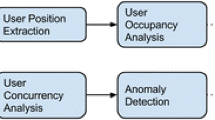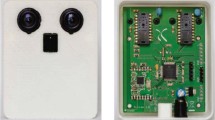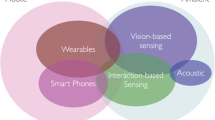Abstract
In the past 10 years, the concept of smart homes and buildings has become progressively mainstream with the introduction of several commercial solutions and available sensor technologies. One of the most important aspects of a smart home system is sensing, which is typically leveraged to observe, understand and predict the daily behavior of the occupant. This sensing of a smart home’s occupant extends to personal location estimation, behavior detection, and activity monitoring. However, there is always a trade off between the amount of information that can be sensed and the loss of privacy of the occupant. Cameras coupled with state of the art computer vision algorithms can provide much more nuanced and rich information than binary sensors, like motion sensors, door sensors and so on. Unfortunately, cameras are not well tolerated by people in their homes and other private areas for privacy protection reasons. In this article, an intensive study was performed on a dataset gathered in a smart home test bed equipped with binary motion sensors. Leveraging our previous works in a concurrent activation model that describes an occupant’s mobility along with the newly defined continuity property of a occupant’s mobility, we propose a bipartite sensor graph with intersection sensor nodes that models a occupant’s high level mobility. We then developed a trajectory propagation algorithm, which can generate an occupant’s most probable trajectories and locations. We show that by using the concurrent activation events of a binary motion sensor network we can extract useful high level details of an occupant’s behavior.














Similar content being viewed by others
References
Brooks RR, Ramanathan P, Sayeed AM (2003) Distributed target classification and tracking in sensor networks. Proc IEEE 91(8):1163–1171
Chan M, Campo E, Estève D, Fourniols JY (2009) Smart homescurrent features and future perspectives. Maturitas 64(2):90–97
Cook DJ (2010) Learning setting-generalized activity models for smart spaces. IEEE Intell Syst 2010(99):1
Cook DJ, Youngblood GM, Heierman EO III, Gopalratnam K, Rao S, Litvin A, Khawaja F (2003) Mavhome: an agent-based smart home. PerCom 3:521–524
Cook DJ, Crandall AS, Thomas BL, Krishnan NC (2013) Casas: a smart home in a box. Computer 46(7)
Dawadi PN, Cook DJ, Schmitter-Edgecombe M (2013) Automated cognitive health assessment using smart home monitoring of complex tasks. IEEE Trans Syst Man Cybern Syst 43(6):1302–1313
De D, Song WZ, Xu M, Wang CL, Cook D, Huo X (2012a) Findinghumo: real-time tracking of motion trajectories from anonymous binary sensing in smart environments. In: Distributed computing systems (ICDCS), 2012 IEEE 32nd international conference on, IEEE, pp 163–172
De D, Song WZ, Xu M, Wang CL, Cook D, Huo X (2012b) Findinghumo: Real-time tracking of motion trajectories from anonymous binary sensing in smart environments. In: Proceedings of the 2012 IEEE 32Nd international conference on distributed computing systems, IEEE Computer Society, Washington, DC, USA, ICDCS ’12, pp 163–172. doi:10.1109/ICDCS.2012.76
Demiris G, Hensel B (2008) Technologies for an aging society: a systematic review of smart home applications. Yearb Med Inf, vol 3, pp 33–40. http://view.ncbi.nlm.nih.gov/pubmed/18660873
Ding D, Cooper RA, Pasquina PF, Fici-Pasquina L (2011) Sensor technology for smart homes. Maturitas 69(2):131–136
Fleury A, Vacher M, Noury N (2010) Svm-based multimodal classification of activities of daily living in health smart homes: sensors, algorithms, and first experimental results. IEEE Trans Inf Technol Biomed 14(2):274–283
Gentry T (2009) Smart homes for people with neurological disability: State of the art. NeuroRehabilitation 25(3):209–217
Goldberg DE et al (1989) enetic algorithms in search, optimization, and machine learning, vol 412. Addison-wesley Reading, Menlo Park
Helal S, Mann W, El-Zabadani H, King J, Kaddoura Y, Jansen E (2005) The gator tech smart house: a programmable pervasive space. Computer 38(3):50–60
Jakkula V, Cook DJ (2008) Anomaly detection using temporal data mining in a smart home environment. Methods Inf Med 47(1):70–75
Kientz JA, Patel SN, Jones B, Price E, Mynatt ED, Abowd GD (2008) The georgia tech aware home. In: CHI’08 extended abstracts on human factors in computing systems, ACM, pp 3675–3680
Kleinberger T, Becker M, Ras E, Holzinger A, Müller P (2007) Ambient intelligence in assisted living: enable elderly people to handle future interfaces. Universal access in human–computer interaction, ambient interaction. Springer, Berlin, pp 103–112
Krishnan NC, Cook DJ (2012) Activity recognition on streaming sensor data. Pervasive Mob Comput 10(Part B(0)):138–154
Le Q, Kaplan LM (2011) Target tracking using proximity binary sensors. In: Aerospace conference, 2011 IEEE, pp 1–10
Lee S, Ha KN, Lee KC (2006) A pyroelectric infrared sensor-based indoor location-aware system for the smart home. IEEE Trans Consum Electron 52(4):1311–1317
Lotfi A, Langensiepen C, Mahmoud SM, Akhlaghinia MJ (2012) Smart homes for the elderly dementia sufferers: identification and prediction of abnormal behaviour. J Ambient Intell Hum Comput 3(3):205–218
Mahmoud SM, Lotfi A, Langensiepen C (2011a) Abnormal behaviours identification for an elder’s life activities using dissimilarity measurements. In: Proceedings of the 4th international conference on pervasive technologies related to assistive environments, ACM, p 25
Mahmoud SM, Lotfi A, Langensiepen C (2011b) Behavioural pattern identification in a smart home using binary similarity and dissimilarity measures. In: Intelligent environments (IE), 2011 7th international conference on, IEEE, pp 55–60
Moutacalli MT, Marmen V, Bouzouane A, Bouchard B (2013) Activity pattern mining using temporal relationships in a smart home. In: Computational intelligence in healthcare and e-health (CICARE), 2013 IEEE Symposium on, IEEE, pp 83–87
Rashidi P, Cook DJ, Holder LB, Schmitter-Edgecombe M (2011) Discovering activities to recognize and track in a smart environment. IEEE Trans Knowl Data Eng 23(4):527–539
Zhang Y, Wang W, Liu S, Xie G (2014) Real-time shop-floor production performance analysis method for the internet of manufacturing things. Adv Mech Eng
Zhang YF, Wang JQ, Sun SD (2012) Real-time information capturing and integration framework of the internet of manufacturing things. Appl Mech Mater 121:4059–4063
Author information
Authors and Affiliations
Corresponding author
Rights and permissions
About this article
Cite this article
Zhang, T., Wong, K.BY. & Aghajan, H. Concurrent activation events based trajectory propagation in smart environments. J Ambient Intell Human Comput 5, 867–880 (2014). https://doi.org/10.1007/s12652-014-0240-0
Received:
Accepted:
Published:
Issue Date:
DOI: https://doi.org/10.1007/s12652-014-0240-0




